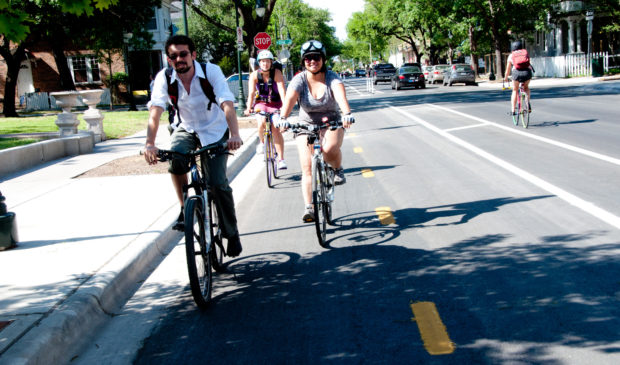Plan to update urban trails, sidewalks and bike lanes prioritizes equity
Friday, June 3, 2022 by
Samuel Stark At the City Council Mobility Committee meeting last month, representatives from the ATX Walk Bike Roll program spoke about their commitment to achieving equitable outcomes when updating Austin’s urban trails, bike lanes and sidewalks.
ATX Walk Bike Roll, a joint planning effort led by the Public Works and Transportation departments, began in 2021 with the hopes of giving Austinites more options than cars or buses when traveling around the city. Project staff members are currently in the design evaluation stage and hope to execute plans in roughly a year’s time.
Half of respondents to a survey conducted by the program said they “strongly” felt that all races don’t have equal access to safe and comfortable paths. Thus the program has ensured that equity is at the heart of its revamp.
“We’re using the Equity Office’s definition where race no longer predicts the quality-of-life outcomes in our community,” Kate Wettick, Austin’s Urban Trails program manager, said in her presentation to the Mobility Committee. “The city of Austin recognizes that past plans and investments have not met the needs of all Austinites or have actively harmed communities, especially low-income communities and communities of color.” She said this furthered inequalities in transportation, health, safety, housing and income.
To achieve its equity goals, the program has engaged community ambassadors from underrepresented populations to find out which updates to infrastructure will have a meaningful impact.
“The team was really looking for people with already deep and established relationships with their communities to give feedback (on what can be improved),” said Emily Smith, a spokesperson for Public Works.
But improvements to infrastructure may be a double-edged sword. The community ambassador engagement showed that members of historically underrepresented communities were concerned that updates to this type of transportation infrastructure might lead to a greater risk of displacement because it could encourage gentrification.
To reduce this risk, ATX Walk Bike Roll is seeking to use “anti-displacement resources to make sure we avoid unintended consequences of our work,” Wettick said.
The program hopes to update urban trails by prioritizing shared-use corridors, such as adding more urban trails along rail lines or utility easements.
With bike paths, the plan is to focus on access to nature, connection to neighborhood destinations or citywide destinations. This is a slight shift from Austin’s 2014 bicycle plan, which focused mostly on enhancing connections to citywide destinations, said Nathan Wilkes, who also works on the ATX Walk Bike Roll program.
By improving “access to nature, we could address parkland-deficient areas,” Wilkes said. “Having mobility choices really impacts who we are as a city and us individually.”
Lastly, the sidewalk portion of the update aims to focus on alternatives to sidewalks for safe pedestrian transportation. One example is a Shared Streets program, which looks for streets where there is currently no footpath and considers how they could be shared with pedestrians.
“If we have 2,500 miles of missing sidewalks, could we take some of those miles and turn them into shared space?” said Laura Dierenfield of the Austin Transportation Department.
Representatives of ATX Walk Bike Roll plan to assess community satisfaction with the proposed updates this fall. They anticipate design implementation to begin in the spring or summer of next year.
Photo by BikeTexas, CC BY-SA 2.0, via Wikimedia Commons. This story has been changed since publication to clarify the fact that ATX Walk Bike Roll is led by both the Public Works and Transportation departments and to clarify that the focus of the bike plans will take shape after further outreach.
The Austin Monitor’s work is made possible by donations from the community. Though our reporting covers donors from time to time, we are careful to keep business and editorial efforts separate while maintaining transparency. A complete list of donors is available here, and our code of ethics is explained here.
You're a community leader
And we’re honored you look to us for serious, in-depth news. You know a strong community needs local and dedicated watchdog reporting. We’re here for you and that won’t change. Now will you take the powerful next step and support our nonprofit news organization?







